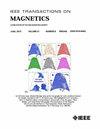掺杂铜粉对 Sm2Co17 永磁体磁性和机械特性的影响
IF 2.1
3区 工程技术
Q3 ENGINEERING, ELECTRICAL & ELECTRONIC
引用次数: 0
摘要
本研究系统地探讨了掺杂铜粉对 Sm2Co17 永磁体的磁性和机械性能的影响。对于高能量产品 Sm2Co17(初始铜含量较低),掺杂 1 wt.% 的铜粉可显著提高本征矫顽力,从 11.7 kOe 提高到 25.7 kOe。通量损失(在 300 °C 下浸泡 2 小时)从 7.4% 降至 3.8%,平均抗折强度从 60.2 MPa 提高到 74.1 MPa。对于耐高温的 Sm2Co17(初始铜含量较高),掺入 1 wt.% 的铜粉后,其本征矫顽力从 39.2 kOe 轻微降至 38.3 kOe。磁通量损失(在 300 °C 下浸泡 2 小时)从 1.4% 增加到 3.4%,平均抗折强度从 86.7 MPa 提高到 93.2 MPa。这两种 Sm2Co17 永磁体磁性能变化的差异与它们的初始铜含量密切相关。在初始铜含量较低的磁体中,掺杂的铜容易扩散到晶胞内边界。晶胞内边界中铜含量的增加有利于提高本征矫顽力,从而增强热稳定性并减少磁通量损失。掺杂铜粉可能会增加接地边界周围的富铜相,从而阻碍热处理过程中的晶粒生长。晶粒尺寸的减小会提高抗弯强度,同时也会增加磁通量损失。本文章由计算机程序翻译,如有差异,请以英文原文为准。
The Influence of Cu Powders Doping on Magnetic and Mechanical Properties of Sm₂Co₁₇ Permanent Magnets
In this work, the influence of Cu powders doping on the magnetic and mechanical properties of Sm2Co17 permanent magnets is systematically investigated. For high-energy-product Sm2Co17 (low initial Cu content), the intrinsic coercivity is significantly improved from 11.7 to 25.7 kOe with 1 wt.% Cu powders doping. The flux loss (soaking at 300 °C for 2 h) is reduced from 7.4% to 3.8%, and the average flexure strength is improved from 60.2 to 74.1 MPa. For high-temperature-resistant Sm2Co17 (high initial Cu content), the intrinsic coercivity is slightly reduced from 39.2 to 38.3 kOe with 1 wt.% Cu powders doping. The flux loss (soaking at 300 °C for 2 h) is increased from 1.4% to 3.4%, and the average flexure strength is improved from 86.7 to 93.2 MPa. The differences in magnetic properties change of these two Sm2Co17 permanent magnets are closely related with their initial Cu content. The doped Cu is prone to diffuse into intragranular cell boundaries in magnet with low initial Cu content. The increased Cu content in intragranular cell boundaries benefits the improvement of intrinsic coercivity, thus enhancing the thermal stability and reducing the flux loss. Doping Cu powders may increase the Cu-rich phase around ground boundaries, which will hinder the grain growth during heat treatment. The decrease of grain size will enhance the flexure strength, while it will increase the flux loss.
求助全文
通过发布文献求助,成功后即可免费获取论文全文。
去求助
来源期刊

IEEE Transactions on Magnetics
工程技术-工程:电子与电气
CiteScore
4.00
自引率
14.30%
发文量
565
审稿时长
4.1 months
期刊介绍:
Science and technology related to the basic physics and engineering of magnetism, magnetic materials, applied magnetics, magnetic devices, and magnetic data storage. The IEEE Transactions on Magnetics publishes scholarly articles of archival value as well as tutorial expositions and critical reviews of classical subjects and topics of current interest.
 求助内容:
求助内容: 应助结果提醒方式:
应助结果提醒方式:


